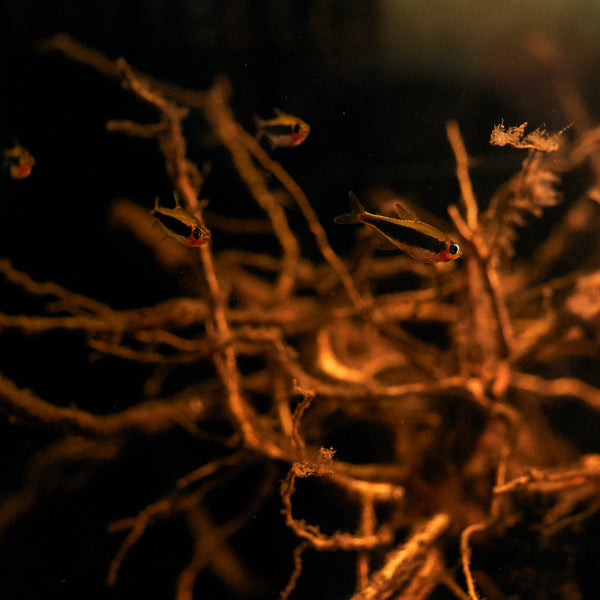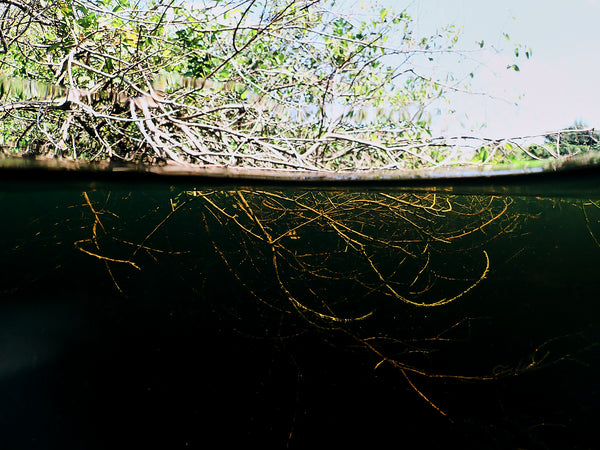- Continue Shopping
- Your Cart is Empty
Under "cover..."
A funny thing happens when terrestrial materials make contact with water: They start to recruit "stuff" on their surfaces. Scientists refer to this "stuff" as "periphyton." Periphyton is a mix of algae, heterotrophic microbes, detritus, and cyanobacteria growths that is attached to submerged surfaces in aquatic ecosystems.
In the hobby, we tend to give it the rather user-friendly moniker of "biocover."
Like it or not, it's found in Nature and in the aquarium almost universally. It's not a reflection on your tank maintenance capabilities, or an indication that your tank is somehow "dirty." Rather, it's an important foundation for food sources, recycling and assimilation of nutrients, and the physical removal of detritus and other particulate matter.

Of course, to many hobbyists, it's considered "unsightly" or "sloppy." To the enlightened, botanical-style aquarium enthusiast, "biocover" is a thing of beauty...an indicator that Nature is doing what she's supposed to do to take advantage of the resources available to Her within the ecosystem, for the benefit of all the organisms which reside there.

Some of the most compelling things in natural aquatic habitats- and in the aquariums which we create to represent them- are large branches, fallen trees, logs, and roots extending from the terrestrial habitat below the waterline.

The result of a tree, branch, or root system which finds its way into the water is a physical, environmental, and water-flow-dynamic-changing feature in the habitat.

I love fallen trees and branches.
I love what they can do. What they can bring to an aquatic environment.
I love how they inspire us.
I love the idea of doing an aquarium in which the primary feature is a big old piece of wood, covered in biofilm, algae, and other life forms.
Notice I didn't say "aquatic moss?" Why? Well, besides the fact that it's sort of an aquascaping contest cliche by now, I don't think it looks all that "authentic." Although I like the look of these features, personally, I have yet to see a moss-covered log in the Amazon region, or in an Asian blackwater swamp, and we need to accept- not fight- some of what really happens in Nature, and readjust our aesthetic sensibilities to understand what is really natural beauty.
It's not all neat and orderly and crisp green on brown.
It's just not.

As we've mentioned numerous times here, Nature is not exactly a neat and tidy, perfectly-ratioed place. Rather it's often a world of chaos, randomness, detritus, biofilms, and fungal growth.

I think we have to sort of "desensitize" ourselves from the stigma of "biocover" on our wood. Now, I know, this idea undermines a century of aquarium-keeping/aquascaping dogma, which suggests that wood in the aquarium must be pristine, and without anything going on it (outside of the aforementioned mosses, in the last decade or so). As hobbyists, we often obsessively remove this stuff as fast as it appears- not only denying Nature a chance to appear in Her most raw and elegant state- we're also simultaneously removing a critical microhabitat which provides environmental stability.
And of course, that's really sort of antithetical to what happens in Nature!
When terrestrial materials fall into the water, opportunistic life forms, ranging from algae to fungi to bacteria- even sponges-will colonize the available space, eking out a living as they compete for resources. In addition to helping to break down some of these terrestrial materials, the life forms that inhabit submerged tree branches and such reproduce rapidly, providing forage for insects and aquatic crustaceans, which, in turn are preyed upon by fishes.
Yeah, a food chain...started by a piece of tree that fell in the forest, and was covered by water during periods of inundation.

If you look at the way the "biocover" grows on these materials, it's obvious that it does so in a manner which helps it absorb light, dissolved oxygen, and nutrients from the water column. The largest, broadest surfaces are covered.

These mats of periphyton- what many hobbyists would characterize as "unsightly growth" are some of Nature's most beautiful and elegant systems, optimized to exploit the dynamic environment in which they are situated. An enormous abundance of life is present, if we just take a few minutes to look for it, and appreciate it.
I think that we can "ease into" appreciating the periphyton by setting up aquariums to provide optimum conditions for them to appear and multiply...and then leaving them undisturbed. That is, a system with lots of different exposed woodsurfaces and a network of roots. An irresistible subject for a natural-looking- and functioning- aquascape!
And relatively easy to execute, too!
With a variety of interesting natural materials readily available to us, it's easier than ever to recreate these habitats in as detailed a version as you care to do.

And the inspiration is literally everywhere in Nature. All you need to do is open your eyes, and instead of "mentally editing" all of the "unsightly" growth, embrace what it looks like sand think about its function and the benefits it brings.
A good starting point on your road to appreciating the periphyton is to consider the very structure of the aquatic habitats that we are inspired by, and thinking about what forces and circumstances helped create them- and why fishes are attracted to them. Look at the way rocks, soil and branches come together in Nature to form interesting physical spaces that fishes utilize for protection, foraging, and reproduction.

By replicating the complex look and physical attributes of these features, including rich substrate, roots of various thickness, and leaves, we offer our fishes all sorts of potential microhabitats. In the aquarium, we tend to focus on the "macro" level- creating a nice wood stack, perhaps incorporating some rock- but we seldom see the whole picture allowed to come together in a more natural way.

This was what has inspired me in most of my latest iterations of my home aquariums. The interaction between the terrestrial elements and the aquatic ones is so compelling. Allowing terrestrial leaves to accumulate naturally among the "tree root structures" that I have created fosters this more natural-functioning environment.
As the leaves and roots begin to soften and ultimately break down, they will foster microbial growth, biofilms, and fungal growths- all of which will provide supplemental foods for the resident fishes...just like what happens in Nature.

Facilitating these processes- allowing the materials to accumulate naturally and break down "in situ" is a key component of replicating and supporting these microhabitats in our aquariums. The typical aquarium hardscape- artistic and beautiful as it might be, generally replicates the most superficial aesthetic aspects of such habitats, and tends to overlook their function- and the reasons why such habitats form.
We can- and should- go further.

Now, we see many aquariums which feature wood and leaves, of course. However, I think we don't see a tremendous use of smaller branches, roots, and "twig-sized" pieces, and I think that is something we would definitely like to see more of in our aquariums. There is something remarkably realistic about the presence of these smaller materials in an aquarium.



2 Responses
Scott Fellman
Hi Sean,
Sorry to hear of your issue. We received (today, in fact). a request for a refund from PayPal, which, if you check, you’ll see was granted immediate;y. Since you decided to share your experience here, I’ll take a moment to respond here. We have received NO correspondence about this matter prior to your request for a refund from PayPal. NONE, Zilch. Normally, I wouldn’t even address this publicly, but I think you should know. I checked our inboxes, spam, junk, folders and show no email received from you whatsoever from the email address associated with your order. If we did, you would have received an immediate response, as we’re pretty obsessive about such things. And, if you check the tracking on your order, USPS shows that it WAS delivered to your address. Obviously, that’s not the point anymore. I’m not sure what happened, but it should have been resolved easily if we received your correspondence. Since you are one of only 3 such complaints we’ve received (yes, 3) since 2015, I figured that it would make you feel better to know that, when we actually receive a complaint, we respond. Immediately. Often with a refund and no questions asked, other than to find out what happen so that we can prevent issues from happening again in the future. That being said, we apologize for what has obviously been a difficult situation for you. Again, thanks for your initial order. However, we will not be accepting orders from you in the future, so please do not order from us again. Thanks.
Scott
Sean Kanzenbach
The worst customer service! I purchased product from tannin aquatics over a month ago! Never received my purchased item. Have been trying to get ahold of them with multiple attempts to see where it may be. I have now turned to getting a refund cause I don’t even want the product anymore. I just want my money back for the lack of communication. Don’t buy!






Scott Fellman
Author